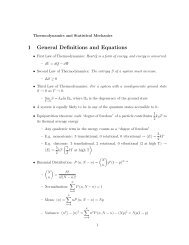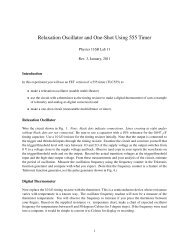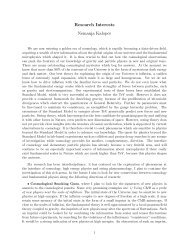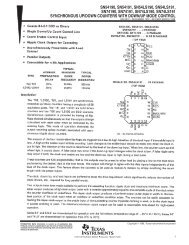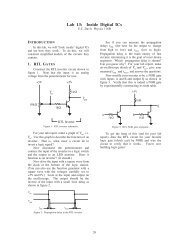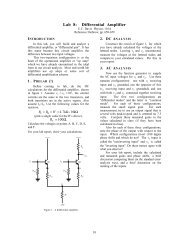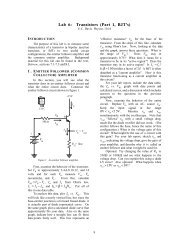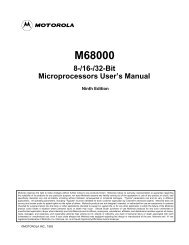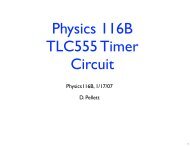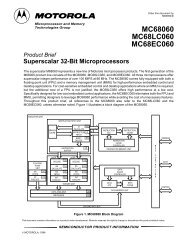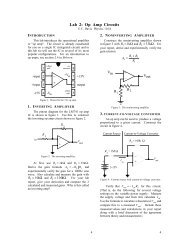Topological semimetal and Fermi-arc surface states in the electronic ...
Topological semimetal and Fermi-arc surface states in the electronic ...
Topological semimetal and Fermi-arc surface states in the electronic ...
Create successful ePaper yourself
Turn your PDF publications into a flip-book with our unique Google optimized e-Paper software.
Selected for a Viewpo<strong>in</strong>t <strong>in</strong> Physics<br />
PHYSICAL REVIEW B 83, 205101 (2011)<br />
<strong>Topological</strong> <strong>semimetal</strong> <strong>and</strong> <strong>Fermi</strong>-<strong>arc</strong> <strong>surface</strong> <strong>states</strong> <strong>in</strong> <strong>the</strong> <strong>electronic</strong> structure of pyrochlore iridates<br />
Xiangang Wan, 1 Ari M. Turner, 2 Ashv<strong>in</strong> Vishwanath, 2,3 <strong>and</strong> Sergey Y. Savrasov 1,4<br />
1 National Laboratory of Solid State Microstructures <strong>and</strong> Department of Physics, Nanj<strong>in</strong>g University, Nanj<strong>in</strong>g 210093, Ch<strong>in</strong>a<br />
2 Department of Physics, University of California, Berkeley, California 94720, USA<br />
3 Materials Sciences Division, Lawrence Berkeley National Laboratory, Berkeley, California 94720, USA<br />
4 Department of Physics, University of California, Davis, One Shields Avenue, Davis, California 95616, USA<br />
(Received 23 February 2011; published 2 May 2011)<br />
We <strong>in</strong>vestigate novel phases that emerge from <strong>the</strong> <strong>in</strong>terplay of electron correlations <strong>and</strong> strong sp<strong>in</strong>-orbit<br />
<strong>in</strong>teractions. We focus on describ<strong>in</strong>g <strong>the</strong> topological <strong>semimetal</strong>, a three-dimensional phase of a magnetic solid,<br />
<strong>and</strong> argue that it may be realized <strong>in</strong> a class of pyrochlore iridates (such as Y2Ir2O7) based on calculations us<strong>in</strong>g<br />
<strong>the</strong> LDA + U method. This state is a three-dimensional analog of graphene with l<strong>in</strong>early dispers<strong>in</strong>g excitations<br />
<strong>and</strong> provides a condensed-matter realization of Weyl fermions that obeys a two-component Dirac equation. It<br />
also exhibits remarkable topological properties manifested by <strong>surface</strong> <strong>states</strong> <strong>in</strong> <strong>the</strong> form of <strong>Fermi</strong> <strong>arc</strong>s, which<br />
are impossible to realize <strong>in</strong> purely two-dimensional b<strong>and</strong> structures. For <strong>in</strong>termediate correlation strengths, we<br />
f<strong>in</strong>d this to be <strong>the</strong> ground state of <strong>the</strong> pyrochlore iridates, coexist<strong>in</strong>g with noncoll<strong>in</strong>ear magnetic order. A narrow<br />
w<strong>in</strong>dow of magnetic “axion” <strong>in</strong>sulator may also be present. An applied magnetic field is found to <strong>in</strong>duce a<br />
metallic ground state.<br />
DOI: 10.1103/PhysRevB.83.205101 PACS number(s): 71.27.+a, 03.65.Vf<br />
Previously, some of <strong>the</strong> most strik<strong>in</strong>g phenomena <strong>in</strong> solids,<br />
such as high-temperature superconductivity 1 <strong>and</strong> colossal<br />
magnetoresistance, 2 were found <strong>in</strong> transition-metal systems<br />
<strong>in</strong>volv<strong>in</strong>g 3d orbitals with strong electron correlations. Now<br />
it has been realized that <strong>in</strong> 4d <strong>and</strong> 5d systems, whose orbitals<br />
are spatially more extended, a regime of <strong>in</strong>termediate correlation<br />
appears. Moreover, <strong>the</strong>y display significant sp<strong>in</strong>-orbit<br />
coupl<strong>in</strong>g, which modifies <strong>the</strong>ir <strong>electronic</strong> structure as recently<br />
verified <strong>in</strong> Sr2IrO4 (Ref. 3). This is a largely unexplored<br />
doma<strong>in</strong>, but already tantaliz<strong>in</strong>g new phenomena have been<br />
glimpsed. For example, <strong>in</strong> <strong>the</strong> 5d iridium-based magnetic<br />
<strong>in</strong>sulator, Na4Ir3O8 (Ref. 4), a disordered ground state persists<br />
down to <strong>the</strong> lowest measured temperatures, mak<strong>in</strong>g it a prime<br />
c<strong>and</strong>idate for a quantum sp<strong>in</strong> liquid. 5<br />
It is known that strong sp<strong>in</strong>-orbit <strong>in</strong>teractions can lead to a<br />
novel phase of matter, <strong>the</strong> topological <strong>in</strong>sulator. 6 However, <strong>the</strong><br />
bismuth-based experimental realizations uncovered so far have<br />
weak electron correlations. Recently, it was po<strong>in</strong>ted out that<br />
<strong>the</strong> iridium oxides (iridates) are promis<strong>in</strong>g c<strong>and</strong>idates to realize<br />
topological <strong>in</strong>sulators 7 <strong>and</strong> that iridium-based pyrochlores <strong>in</strong><br />
particular 8 provide a unique opportunity to study <strong>the</strong> <strong>in</strong>terplay<br />
of Coulomb <strong>in</strong>teractions, sp<strong>in</strong>-orbit coupl<strong>in</strong>g, <strong>and</strong> <strong>the</strong> b<strong>and</strong><br />
topology of solids.<br />
The ma<strong>in</strong> focus of our work is <strong>the</strong> pyrochlore iridates,<br />
which have <strong>the</strong> general formula A2Ir2O7, where A = yttrium<br />
or a lanthanide element. Experiments on <strong>the</strong>se materials<br />
<strong>in</strong>dicate magnetic order. 9,10 Thus, <strong>the</strong> possible phases have<br />
not been treated <strong>in</strong> <strong>the</strong> <strong>the</strong>ory of topological <strong>in</strong>sulators, which<br />
assumes time-reversal symmetry. A ra<strong>the</strong>r different, but also<br />
unusual phase, <strong>the</strong> topological <strong>semimetal</strong> is predicted by our<br />
LSDA + U + SO (where LSDA st<strong>and</strong>s for local-sp<strong>in</strong>-density<br />
approximation <strong>and</strong> SO st<strong>and</strong>s for sp<strong>in</strong> orbit) calculations <strong>in</strong><br />
a range of parameters appropriate to <strong>the</strong> iridates. This phase<br />
has l<strong>in</strong>early dispers<strong>in</strong>g excitations at <strong>the</strong> chemical potential,<br />
analogous to graphene, 11 but occurs <strong>in</strong>side a fully threedimensional<br />
magnetic solid. The small density of <strong>states</strong> leads<br />
to a vanish<strong>in</strong>g conductivity at low temperatures. Each mode<br />
<strong>in</strong> this metal is described by a two-component wave-function<br />
(described by <strong>the</strong> “Weyl equation,” <strong>the</strong> two-component analog<br />
of <strong>the</strong> Dirac equation), describ<strong>in</strong>g a po<strong>in</strong>t where two b<strong>and</strong>s<br />
touch. The Weyl equation is used <strong>in</strong> particle physics to describe<br />
<strong>the</strong> chiral <strong>and</strong> massless behavior of neutr<strong>in</strong>os (<strong>in</strong> limits where<br />
<strong>the</strong>ir small mass can be neglected). Hence, we also call it <strong>the</strong><br />
“Weyl <strong>semimetal</strong>.”<br />
Weyl fermions can be assigned a chirality; that is, <strong>the</strong>y are<br />
ei<strong>the</strong>r left or right h<strong>and</strong>ed. These modes cannot be gapped<br />
unless <strong>the</strong>y mix with a fermion of opposite h<strong>and</strong>edness, which<br />
is located at a different po<strong>in</strong>t <strong>in</strong> <strong>the</strong> Brillou<strong>in</strong> zone. Thus <strong>the</strong><br />
gaplessness of Weyl fermions is absolute provided momentum<br />
is conserved; 12 it does not require any f<strong>in</strong>e-tun<strong>in</strong>g or symmetry.<br />
These modes are most robust <strong>in</strong> systems with magnetic order.<br />
They do not exist at all if both time reversal <strong>and</strong> <strong>in</strong>version<br />
symmetry are present, for example, <strong>in</strong> bismuth. There, <strong>in</strong><br />
contrast, Dirac fermions with four-component wave functions<br />
appear, which are typically gapped.<br />
A key property of <strong>the</strong> Weyl <strong>semimetal</strong> phase studied <strong>in</strong> this<br />
work is its unusual <strong>surface</strong> <strong>states</strong>, rem<strong>in</strong>iscent of topological<br />
<strong>in</strong>sulators. S<strong>in</strong>ce <strong>the</strong> bulk fermi <strong>surface</strong> only consists of a set<br />
of momentum po<strong>in</strong>ts, <strong>surface</strong> <strong>states</strong> can be def<strong>in</strong>ed for nearly<br />
every <strong>surface</strong> momentum <strong>and</strong> take <strong>the</strong> shape of “<strong>Fermi</strong> <strong>arc</strong>s”<br />
<strong>in</strong> <strong>the</strong> <strong>surface</strong> Brillou<strong>in</strong> zone that stretch between Weyl po<strong>in</strong>ts.<br />
The “axion <strong>in</strong>sulator” phase can emerge when <strong>the</strong> Weyl<br />
po<strong>in</strong>ts annihilate <strong>in</strong> pairs as <strong>the</strong> correlations are reduced. This<br />
phase shows a topological magnetoelectric effect, 13 captured<br />
by <strong>the</strong> magnetoelectric parameter θ = π, whose value is<br />
protected by <strong>the</strong> <strong>in</strong>version symmetry, which is respected <strong>in</strong><br />
our system. The name axion <strong>in</strong>sulator refers to <strong>the</strong> analogy<br />
with <strong>the</strong> axion vacuum <strong>in</strong> particle physics. 14<br />
In <strong>the</strong> pyrochlore iridates both <strong>the</strong> A <strong>and</strong> <strong>the</strong> Ir atoms<br />
are located on a network of corner-shar<strong>in</strong>g tetrahedra. 15,16<br />
Pioneer<strong>in</strong>g experiments 17 revealed an evolution of groundstate<br />
properties with <strong>in</strong>creas<strong>in</strong>g radius of <strong>the</strong> A ion, which is<br />
believed to tune electron correlations. While A = Pr is metallic,<br />
A = Y is an <strong>in</strong>sulator at low temperatures. Subsequently,<br />
1098-0121/2011/83(20)/205101(9) 205101-1<br />
©2011 American Physical Society
WAN, TURNER, VISHWANATH, AND SAVRASOV PHYSICAL REVIEW B 83, 205101 (2011)<br />
it was shown that <strong>the</strong> <strong>in</strong>sulat<strong>in</strong>g ground <strong>states</strong> evolve from a<br />
high-temperature metallic phase via a magnetic transition. 9,10<br />
The magnetism was shown to arise from <strong>the</strong> Ir sites, s<strong>in</strong>ce it<br />
also occurs <strong>in</strong> A = Y, Lu, where <strong>the</strong> A sites are nonmagnetic.<br />
While its precise nature rema<strong>in</strong>s unknown, ferromagnetic<br />
order<strong>in</strong>g is considered unlikely, s<strong>in</strong>ce magnetic hysteresis is<br />
not observed.<br />
We show that <strong>electronic</strong> structure calculations can naturally<br />
account for this evolution <strong>and</strong> po<strong>in</strong>t to a novel ground state.<br />
First, we f<strong>in</strong>d that magnetic moments order on <strong>the</strong> Ir sites<br />
<strong>in</strong> a noncoll<strong>in</strong>ear pattern with moment on a tetrahedron<br />
po<strong>in</strong>t<strong>in</strong>g all <strong>in</strong> or all out from <strong>the</strong> center. This structure reta<strong>in</strong>s<br />
<strong>in</strong>version symmetry, a fact that greatly aids <strong>the</strong> <strong>electronic</strong><br />
structure analysis. While <strong>the</strong> magnetic pattern rema<strong>in</strong>s fixed,<br />
<strong>the</strong> <strong>electronic</strong> properties evolve with correlation strength. For<br />
weak correlations, or <strong>in</strong> <strong>the</strong> absence of magnetic order, a<br />
metal is obta<strong>in</strong>ed, <strong>in</strong> contrast to <strong>the</strong> <strong>in</strong>terest<strong>in</strong>g topological<br />
<strong>in</strong>sulator scenario of Ref. 8. With strong correlations we f<strong>in</strong>d<br />
a Mott <strong>in</strong>sulator with all-<strong>in</strong>/all-out magnetic order. However,<br />
for <strong>the</strong> case of <strong>in</strong>termediate correlations, relevant to Y2Ir2O7,<br />
<strong>the</strong> <strong>electronic</strong> ground state is found to be a Weyl <strong>semimetal</strong>,<br />
with l<strong>in</strong>early dispers<strong>in</strong>g Dirac nodes at <strong>the</strong> chemical potential<br />
<strong>and</strong> o<strong>the</strong>r properties described above.<br />
We also mention <strong>the</strong> possibility of an exotic <strong>in</strong>sulat<strong>in</strong>g<br />
phase emerg<strong>in</strong>g when <strong>the</strong> Weyl po<strong>in</strong>ts annihilate <strong>in</strong> pairs<br />
as <strong>the</strong> correlations are reduced; we call it <strong>the</strong> θ = π axion<br />
<strong>in</strong>sulator. Although our LSDA + U + SO calculations f<strong>in</strong>d<br />
that a metallic phase <strong>in</strong>tervenes before this possibility is<br />
realized, we note that local-density approximation (LDA)<br />
systematically underestimates gaps, so this scenario could well<br />
occur <strong>in</strong> reality. F<strong>in</strong>ally, we mention that modest magnetic<br />
fields could <strong>in</strong>duce a reorientation of <strong>the</strong> magnetic moments,<br />
lead<strong>in</strong>g to a metallic phase. Previous studies <strong>in</strong>clude Ref. 18,an<br />
ab <strong>in</strong>itio study which considered ferromagnetism. In Ref. 19,<br />
<strong>the</strong> tight-b<strong>in</strong>d<strong>in</strong>g model of Ref. 8 was extended to <strong>in</strong>clude<br />
tetragonal crystal fields, but <strong>in</strong> <strong>the</strong> absence of magnetism. The<br />
topological Dirac metal <strong>and</strong> axion <strong>in</strong>sulator discussed here do<br />
not appear <strong>in</strong> those works, largely due to <strong>the</strong> difference of<br />
magnetic order from our study.<br />
We beg<strong>in</strong> by giv<strong>in</strong>g a brief overview of <strong>the</strong> <strong>the</strong>oretical<br />
ideas that will be <strong>in</strong>voked <strong>in</strong> this work, before turn<strong>in</strong>g to our<br />
LSDA + U calculations of magnetic <strong>and</strong> <strong>electronic</strong> structure<br />
of <strong>the</strong> pyrochlore iridates. We <strong>the</strong>n discuss <strong>the</strong> special <strong>surface</strong><br />
<strong>states</strong> that arise <strong>in</strong> <strong>the</strong> Weyl <strong>semimetal</strong> phase <strong>and</strong> close with<br />
a comparison to exist<strong>in</strong>g experiments <strong>and</strong> conclusions. Our<br />
results are summarized <strong>in</strong> <strong>the</strong> phase diagram Fig. 1.<br />
I. WEYL SEMIMETALS AND INVERSION-SYMMETRIC<br />
INSULATORS<br />
Weyl po<strong>in</strong>ts are po<strong>in</strong>ts where <strong>the</strong> valence b<strong>and</strong> <strong>and</strong><br />
conduction b<strong>and</strong> touch. The excitations near each Weyl po<strong>in</strong>t<br />
k0 are described by an effective Hamiltonian:<br />
HD = E01 + v0 · q1 +<br />
3<br />
vi · qσi. (1)<br />
Energy is measured from <strong>the</strong> chemical potential, q = k − k0<br />
<strong>and</strong> (1,σi) are <strong>the</strong> identity matrix <strong>and</strong> three Pauli matrices,<br />
respectively. This Hamiltonian is obta<strong>in</strong>ed by exp<strong>and</strong><strong>in</strong>g <strong>the</strong><br />
i=1<br />
205101-2<br />
FIG. 1. (Color onl<strong>in</strong>e) Sketch of <strong>the</strong> predicted phase diagram<br />
for pyrochlore iridiates. The horizontal axis corresponds to <strong>the</strong><br />
<strong>in</strong>creas<strong>in</strong>g <strong>in</strong>teraction among Ir 5d electrons while <strong>the</strong> vertical axis<br />
corresponds to external magnetic field, which can trigger a transition<br />
out of <strong>the</strong> noncoll<strong>in</strong>ear “all-<strong>in</strong>/all-out” ground state, which has several<br />
<strong>electronic</strong> phases.<br />
full Hamiltonian to l<strong>in</strong>ear order. No assumptions are needed<br />
beyond <strong>the</strong> requirement that <strong>the</strong> two eigenvalues become<br />
degenerate at k0. The velocity vectors vi are generically<br />
nonvanish<strong>in</strong>g <strong>and</strong> l<strong>in</strong>early <strong>in</strong>dependent. The energy dispersion<br />
3<br />
is conelike, E = v0 · q ± i=1 (vi · q) 2 . One can assign a<br />
chirality (or chiral charge) c =±1to <strong>the</strong> fermions def<strong>in</strong>ed as<br />
c = sgn(v1 · v2 × v3). Note that, s<strong>in</strong>ce <strong>the</strong> 2 × 2 Pauli matrices<br />
appear, our Weyl particles are two-component fermions. In<br />
contrast to regular four component Dirac fermions, it is not<br />
possible to <strong>in</strong>troduce a mass gap. The only way for <strong>the</strong>se modes<br />
to disappear is if <strong>the</strong>y meet with ano<strong>the</strong>r two-component Weyl<br />
fermion <strong>in</strong> <strong>the</strong> Brillou<strong>in</strong> zone, but with opposite chiral charge.<br />
Thus, <strong>the</strong>y are topological objects. By <strong>in</strong>version symmetry, <strong>the</strong><br />
b<strong>and</strong> touch<strong>in</strong>gs come <strong>in</strong> pairs, at k0 <strong>and</strong> −k0, <strong>and</strong> <strong>the</strong>se have<br />
opposite chiralities (s<strong>in</strong>ce <strong>the</strong> velocity vectors are reversed).<br />
This <strong>semimetal</strong>lic behavior would not occur (generically)<br />
<strong>in</strong> a system without magnetic order. In materials such as<br />
bismuth, with both time reversal <strong>and</strong> <strong>in</strong>version symmetry,<br />
Dirac fermions always conta<strong>in</strong> both left- <strong>and</strong> right-h<strong>and</strong>ed<br />
components <strong>and</strong> are thus typically gapped. 20<br />
When <strong>the</strong> compound has stoichiometric composition, <strong>and</strong><br />
all <strong>the</strong> Weyl po<strong>in</strong>ts are related by symmetry, <strong>the</strong> <strong>Fermi</strong> energy<br />
can generically l<strong>in</strong>e up with <strong>the</strong> energy of <strong>the</strong> touch<strong>in</strong>g po<strong>in</strong>ts.<br />
Under <strong>the</strong>se circumstances, <strong>the</strong> density of <strong>states</strong> is equal to<br />
zero <strong>and</strong> <strong>the</strong> behavior of <strong>the</strong> Weyl fermions controls <strong>the</strong><br />
low-temperature physics of <strong>the</strong> solid. For example, <strong>the</strong> ac<br />
conductivity should have a particular frequency dependence,<br />
<strong>and</strong> novel types of <strong>surface</strong> <strong>states</strong> should occur, as discussed<br />
below. Because of <strong>the</strong> symmetry relat<strong>in</strong>g <strong>the</strong> Weyl po<strong>in</strong>ts,<br />
<strong>the</strong>ir energies E0 must co<strong>in</strong>cide. Then, <strong>the</strong> <strong>Fermi</strong> energy is<br />
fixed at <strong>the</strong> touch<strong>in</strong>g po<strong>in</strong>ts because of <strong>the</strong> Kohn-Lutt<strong>in</strong>ger<br />
<strong>the</strong>orem: At stoichiometry, <strong>the</strong>re are an <strong>in</strong>teger number of<br />
electrons per unit cell. Hence, <strong>the</strong> Kohn-Lutt<strong>in</strong>ger <strong>the</strong>orem<br />
implies that <strong>the</strong> volume of particlelike m<strong>in</strong>us holelike <strong>Fermi</strong><br />
<strong>surface</strong>s must be a multiple of <strong>the</strong> volume of <strong>the</strong> Brillou<strong>in</strong>
TOPOLOGICAL SEMIMETAL AND FERMI-ARC SURFACE ... PHYSICAL REVIEW B 83, 205101 (2011)<br />
zone. If <strong>the</strong> <strong>Fermi</strong> <strong>surface</strong> were slightly above (below) E0,<br />
<strong>the</strong>n <strong>the</strong> <strong>Fermi</strong> <strong>surface</strong>s would all be particle- (hole)-like, <strong>and</strong><br />
<strong>the</strong> Kohn-Lutt<strong>in</strong>ger <strong>the</strong>orem would not be satisfied.<br />
Inversion symmetry provides useful <strong>in</strong>formation about <strong>the</strong><br />
materials we study. Inversion about <strong>the</strong> orig<strong>in</strong> is given by<br />
r →−r; this is a symmetry of many crystals <strong>and</strong>, <strong>in</strong> particular,<br />
of <strong>the</strong> ones we focus on here. Inversion strongly constra<strong>in</strong>s<br />
many physical properties; <strong>in</strong> particular, it leads to a quantized<br />
magnetoelectric susceptibility (see Sec. III) <strong>and</strong> can help p<strong>in</strong><br />
<strong>the</strong> <strong>Fermi</strong> energy exactly at Weyl po<strong>in</strong>ts. F<strong>in</strong>ally, because<br />
of <strong>in</strong>version symmetry, a few <strong>states</strong> <strong>in</strong> <strong>the</strong> b<strong>and</strong> structure<br />
determ<strong>in</strong>e many basic properties of a solid. The symmetry<br />
relates crystal momenta ±k. At special momenta, called<br />
TRIMs (time-reversal <strong>in</strong>variant momenta), which are <strong>in</strong>variant<br />
under <strong>in</strong>version, <strong>the</strong> <strong>states</strong> can be labeled by parity eigenvalues<br />
ξ =±1. These eigenvalues can be used to identify phase<br />
transitions as parameters of <strong>the</strong> system are changed. Whenever<br />
<strong>the</strong> set of eigenvalues associated with occupied <strong>states</strong> changes,<br />
<strong>the</strong>re must be a phase transition. The highest energy level at a<br />
TRIM <strong>in</strong> <strong>the</strong> valence b<strong>and</strong> can cross through <strong>the</strong> lowest energy<br />
level <strong>in</strong> <strong>the</strong> conduction b<strong>and</strong> if <strong>the</strong>ir parities are different, <strong>and</strong><br />
this changes <strong>the</strong> set of ξ’s at that TRIM. Hence, <strong>the</strong> gap passes<br />
through 0. In fact, more is true: The compound cannot be<br />
<strong>in</strong>sulat<strong>in</strong>g on both sides of <strong>the</strong> transition. 21 A pair (or an odd<br />
number of pairs) of Weyl po<strong>in</strong>ts emerge from or are absorbed<br />
<strong>in</strong>to <strong>the</strong> TRIM after <strong>the</strong> parities change (see <strong>the</strong> Appendix for<br />
a derivation <strong>in</strong> <strong>the</strong> context of <strong>the</strong> iridates).<br />
We now turn to results for a particular family of materials,<br />
<strong>the</strong> pyrochlore iridates, where we argue that <strong>the</strong>se general ideas<br />
are realized.<br />
II. LDA CALCULATION AND MAGNETIC ORDER<br />
We focus here on our numerical ab <strong>in</strong>itio studies of <strong>the</strong><br />
compound Y2Ir2O7. We have also done calculations on iridates<br />
with rare earth atoms (Pr,Nd,SmEu)at<strong>the</strong>A site. Chang<strong>in</strong>g<br />
<strong>the</strong> A site has essentially no effect except for chang<strong>in</strong>g <strong>the</strong><br />
appropriate value of U, <strong>the</strong> <strong>in</strong>teraction parameter.<br />
The strength of <strong>the</strong> SO coupl<strong>in</strong>g is large for Ir 5d electrons<br />
<strong>and</strong> leads to <strong>in</strong>sulat<strong>in</strong>g behavior <strong>in</strong> Sr2IrO4 (Ref. 3); we need<br />
to take it <strong>in</strong>to account <strong>in</strong> order to underst<strong>and</strong> <strong>the</strong> magnetic <strong>and</strong><br />
<strong>electronic</strong> properties.<br />
(a) a)<br />
(b) b)<br />
FIG. 2. (Color onl<strong>in</strong>e) The pyrochlore crystal structure show<strong>in</strong>g<br />
<strong>the</strong> Ir corner shar<strong>in</strong>g tetrahedral network <strong>and</strong> two of <strong>the</strong> possible<br />
magnetic configurations. (a) The configuration that is predicted<br />
to occur for iridates, with all-<strong>in</strong>/all-out magnetic order. (b) An<br />
alternative, <strong>the</strong> 2-<strong>in</strong>/2-out configuration.<br />
205101-3<br />
The system conta<strong>in</strong>s four iridium atoms <strong>in</strong>side each unit<br />
cell form<strong>in</strong>g a tetrahedral network as shown <strong>in</strong> Fig. 2. We<br />
perform our <strong>electronic</strong> structure calculations based on local<br />
sp<strong>in</strong> density approximation to density functional <strong>the</strong>ory (DFT)<br />
with <strong>the</strong> full-potential, all-electron, l<strong>in</strong>ear-muff<strong>in</strong>-t<strong>in</strong>-orbital<br />
(LMTO) method. 22 We use a LSDA + U scheme 23 to take<br />
<strong>in</strong>to account <strong>the</strong> electron-electron <strong>in</strong>teraction between Ir 5d<br />
electrons <strong>and</strong> vary parameter U between 0 <strong>and</strong> 3 eV for Ir 5d<br />
electrons to see what effects <strong>the</strong> on-site Coulomb repulsion<br />
would br<strong>in</strong>g to <strong>the</strong> <strong>electronic</strong> structure of iridates. In general,<br />
we expect that U can be somewhere between 1 <strong>and</strong> 2 eV for <strong>the</strong><br />
extended 5d <strong>states</strong>. We use a 24 × 24 × 24 k mesh to perform<br />
Brillou<strong>in</strong>-zone <strong>in</strong>tegration <strong>and</strong> switch off symmetry operations<br />
<strong>in</strong> order to m<strong>in</strong>imize possible numerical errors <strong>in</strong> studies of<br />
various (non-)coll<strong>in</strong>ear configurations. We use experimental<br />
lattice parameters 9 <strong>in</strong> all setups.<br />
With only <strong>the</strong> Heisenberg <strong>in</strong>teraction (<strong>and</strong> no SO coupl<strong>in</strong>g),<br />
sp<strong>in</strong>s <strong>in</strong> <strong>the</strong> pyrochlore configuration would be geometrically<br />
frustrated, so we se<strong>arc</strong>h for <strong>the</strong> proper magnetic configuration<br />
by start<strong>in</strong>g from a large number (12) of different <strong>states</strong>. The<br />
coll<strong>in</strong>ear ones were (i) ferromagnetic, with moment along<br />
(100), (111), (110), or (120) directions, <strong>and</strong> (ii) antiferromagnetic<br />
with two moments <strong>in</strong> a tetrahedron along <strong>and</strong> <strong>the</strong> o<strong>the</strong>r<br />
two po<strong>in</strong>ted oppositely to <strong>the</strong> directions above; noncoll<strong>in</strong>ear<br />
structures were (iii) <strong>the</strong> all-<strong>in</strong>/all-out pattern (all moments<br />
po<strong>in</strong>t to or away from <strong>the</strong> centers of <strong>the</strong> tetrahedron), (iv)<br />
“2-<strong>in</strong>/2-out” (two moments <strong>in</strong> a tetrahedron po<strong>in</strong>t to <strong>the</strong> center<br />
of this tetrahedron, while <strong>the</strong> o<strong>the</strong>r two moments po<strong>in</strong>t away<br />
from <strong>the</strong> center, that is, <strong>the</strong> sp<strong>in</strong>-ice 24 configuration), <strong>and</strong> (v)<br />
“3-<strong>in</strong>/1-out” magnetic structures. We show several magnetic<br />
configurations <strong>in</strong> Fig. 2.<br />
We f<strong>in</strong>d that <strong>the</strong> all-<strong>in</strong>/all-out configuration is <strong>the</strong> ground<br />
state. In contrast to o<strong>the</strong>r magnetic configurations, dur<strong>in</strong>g <strong>the</strong><br />
self-consistent iterations <strong>the</strong> sp<strong>in</strong>s <strong>in</strong> <strong>the</strong> all-<strong>in</strong>/all-out state<br />
reta<strong>in</strong> <strong>the</strong>ir <strong>in</strong>itial <strong>in</strong>put direction; <strong>in</strong>dicat<strong>in</strong>g a local energy<br />
m<strong>in</strong>imum. This state is consistent with <strong>the</strong> absence of magnetic<br />
hysteresis <strong>in</strong> experiments. 9 S<strong>in</strong>ce all <strong>states</strong> considered<br />
were translationally <strong>in</strong>variant q = 0 <strong>states</strong>, <strong>the</strong> possibility of<br />
complex larger q <strong>states</strong> cannot be ruled out.<br />
This particular order is, <strong>in</strong> fact, consistent with <strong>the</strong> predictions<br />
of Ref. 25 for half-<strong>in</strong>teger sp<strong>in</strong>s with SO coupl<strong>in</strong>g on a<br />
pyrochlore lattice, <strong>the</strong> strongly <strong>in</strong>sulat<strong>in</strong>g limit of <strong>the</strong> present<br />
problem. The Dzyalosh<strong>in</strong>sky-Moriya <strong>in</strong>teraction (generated<br />
by <strong>the</strong> SO coupl<strong>in</strong>g) removes <strong>the</strong> frustration of <strong>the</strong> Heisenberg<br />
antiferromagnet.<br />
Symmetry dictates <strong>the</strong> form of Dzyalosh<strong>in</strong>sky-Moriya<br />
<strong>in</strong>teractions except for <strong>the</strong> sign, which leads to two cases,<br />
direct <strong>and</strong> <strong>in</strong>direct Dzyalosh<strong>in</strong>sky-Moriya. The all-<strong>in</strong>/all-out<br />
state is <strong>the</strong> unique ground state for <strong>the</strong> former while <strong>the</strong> <strong>in</strong>direct<br />
Dzyalosh<strong>in</strong>sky-Moriya ground state is a coplanar state with <strong>the</strong><br />
four sp<strong>in</strong>s be<strong>in</strong>g ei<strong>the</strong>r antiparallel or orthogonal. 25 In our case,<br />
<strong>the</strong> <strong>in</strong>direct Dzyalosh<strong>in</strong>sky-Moriya pattern also has higher<br />
energy than <strong>the</strong> all-<strong>in</strong>/all-out state. This correspondence with<br />
<strong>the</strong> magnetic structure <strong>in</strong> <strong>the</strong> strong correlation limit po<strong>in</strong>ts to<br />
<strong>the</strong> simplest magnetic phase diagram of one magnetic structure<br />
spann<strong>in</strong>g a range of correlation strengths.<br />
The next-lowest energy configuration is <strong>the</strong> ferromagnetic<br />
state. Interest<strong>in</strong>gly, <strong>the</strong> rotation of magnetization does not<br />
cost much energy despite strong SO <strong>in</strong>teractions. The (111)<br />
direction is found to be <strong>the</strong> lowest ferromagnetic state, but <strong>the</strong>
WAN, TURNER, VISHWANATH, AND SAVRASOV PHYSICAL REVIEW B 83, 205101 (2011)<br />
TABLE I. The sp<strong>in</strong> 〈S〉 <strong>and</strong> orbital 〈O〉 moment (<strong>in</strong> μB) <strong>and</strong> <strong>the</strong><br />
total energy Etot per unit cell (<strong>in</strong> meV) for several selected magnetic<br />
configurations of Y2Ir2O7 as calculated us<strong>in</strong>g <strong>the</strong> LSDA + U + SO<br />
method with U = 1.5 eV.(Etot is def<strong>in</strong>ed relative to <strong>the</strong> ground<br />
state.) The IDM (<strong>in</strong>direct Dzyalosh<strong>in</strong>sky-Moriya) is a coplanar<br />
configuration predicted for one sign of D-M <strong>in</strong>teractions <strong>in</strong> Ref. 25.<br />
Configuration: (001) (111) 2-<strong>in</strong>/2-out IDM all-<strong>in</strong>/all-out<br />
〈S〉 0.08 0.10 0.09 0.06 0.13<br />
〈O〉 0.09 0.10 0.07 0.06 0.12<br />
Etot (meV) 5.47 1.30 3.02 2.90 0.00<br />
energy difference between this <strong>and</strong> <strong>the</strong> highest energy (001)<br />
state is just about 4.17 meV per unit cell. Also, all of <strong>the</strong>m<br />
produce a considerable net magnetic moment <strong>in</strong> contrast to<br />
<strong>the</strong> experiment. 9,17 Our f<strong>in</strong>d<strong>in</strong>gs are summarized <strong>in</strong> Table I<br />
for a typical value of U = 1.5 eV, <strong>and</strong> similar results are<br />
found for o<strong>the</strong>r values of U <strong>in</strong> <strong>the</strong> range from 0 to 3 eV.<br />
S<strong>in</strong>ce <strong>the</strong> energy difference between <strong>the</strong> ground state <strong>and</strong> <strong>the</strong><br />
o<strong>the</strong>r magnetic order<strong>in</strong>gs is small, modest magnetic fields may<br />
<strong>in</strong>duce a transition <strong>in</strong>to <strong>the</strong> ferromagnetic state.<br />
Similarly, we note that <strong>the</strong> honeycomb-lattice<br />
Ir compound—Na2IrO3—<strong>in</strong>itially proposed as a<br />
two-dimensional quantum sp<strong>in</strong> Hall <strong>in</strong>sulator, 7 was predicted<br />
by LDA + U to be a magnetically ordered Mott phase, 26 for<br />
which some recent experimental support has emerged. 27<br />
III. ELECTRONIC PHASES<br />
We now discuss <strong>electronic</strong> properties of iridates that emerge<br />
from our LSDA + U + SO calculations. A variety of phases<br />
rang<strong>in</strong>g from normal metal at small U to Weyl <strong>semimetal</strong>lic<br />
at <strong>in</strong>termediate U ∼ 1.5 eV <strong>and</strong> Mott <strong>in</strong>sulat<strong>in</strong>g phase at U<br />
above 2 eV with noncoll<strong>in</strong>ear magnetic all-<strong>in</strong>/all-out order<strong>in</strong>g<br />
are predicted. S<strong>in</strong>ce pressure or chemical substitution may<br />
alter <strong>the</strong> screen<strong>in</strong>g <strong>and</strong> <strong>the</strong> <strong>electronic</strong> b<strong>and</strong>width result<strong>in</strong>g <strong>in</strong><br />
changes <strong>in</strong> U, we expect that <strong>the</strong>se phases can be observed<br />
experimentally <strong>in</strong> iridates.<br />
The basic features of <strong>the</strong> <strong>electronic</strong> structure can be<br />
understood by not<strong>in</strong>g that each Ir 4+ is coord<strong>in</strong>ated by six O 2−<br />
form<strong>in</strong>g approximately an octahedron. The Ir 5d orbitals split<br />
<strong>in</strong>to an eg doublet <strong>and</strong> t2g triplet. Due to <strong>the</strong> extended nature<br />
of <strong>the</strong> Ir 5d orbital, <strong>the</strong> crystal-field splitt<strong>in</strong>g between t2g <strong>and</strong><br />
eg is large with <strong>the</strong> eg b<strong>and</strong> to be 2 eV higher than <strong>the</strong> <strong>Fermi</strong><br />
level. The b<strong>and</strong>s near <strong>the</strong> <strong>Fermi</strong> level are ma<strong>in</strong>ly contributed<br />
by Ir t2g with some mix<strong>in</strong>g with O 2p <strong>states</strong>. SO coupl<strong>in</strong>g has a<br />
considerable effect on <strong>the</strong>se t2g <strong>states</strong>: It lifts <strong>the</strong>ir degeneracy<br />
<strong>and</strong> produces a quadruplet with Jeff = 3/2 <strong>and</strong> a higher-energy<br />
Kramers doublet with Jeff = 1/2(Ref.3). The five d electrons<br />
of Ir 4+ fill <strong>the</strong> quadruplet, <strong>and</strong> half fill <strong>the</strong> rema<strong>in</strong><strong>in</strong>g Jeff = 1/2<br />
orbital. The latter can also be viewed as a Ɣ7 doublet, from <strong>the</strong><br />
strong SO limit. Thus, given <strong>the</strong> four Ir atoms <strong>in</strong> <strong>the</strong> unit cell,<br />
we expect eight energy b<strong>and</strong>s near <strong>the</strong> <strong>Fermi</strong> energy, which<br />
are at half fill<strong>in</strong>g.<br />
The precise behavior of <strong>the</strong>se <strong>electronic</strong> <strong>states</strong> depends on<br />
<strong>the</strong> magnetic configuration. Our b<strong>and</strong> structure calculations<br />
for coll<strong>in</strong>ear alignments of moments show metallic b<strong>and</strong>s,<br />
a result that disagrees with <strong>the</strong> <strong>in</strong>sulat<strong>in</strong>g behavior found<br />
experimentally. Increas<strong>in</strong>g U cannot solve this problem, <strong>and</strong><br />
205101-4<br />
FIG. 3. (Color onl<strong>in</strong>e) Evolution of <strong>electronic</strong> b<strong>and</strong> structure of<br />
Y2Ir2O7 shown along high-symmetry directions, calculated us<strong>in</strong>g <strong>the</strong><br />
LSDA + U + SO method with three different values of U equal<br />
(a) 0 (metallic), (b) 1.5 eV, <strong>and</strong> (c) 2 eV (<strong>in</strong>sulator with small<br />
gap). The Weyl po<strong>in</strong>t that is present <strong>in</strong> case (b), is not visible along<br />
high-symmetry l<strong>in</strong>es.<br />
even a quite large U (= 5 eV) cannot open a b<strong>and</strong> gap for<br />
<strong>the</strong> coll<strong>in</strong>ear configuration. On <strong>the</strong> o<strong>the</strong>r h<strong>and</strong>, we f<strong>in</strong>d that <strong>the</strong><br />
<strong>electronic</strong> <strong>states</strong> for <strong>the</strong> noncoll<strong>in</strong>ear all-<strong>in</strong>/all-out magnetic<br />
state depend strongly on <strong>the</strong> actual value of U used <strong>in</strong> <strong>the</strong><br />
calculation. In particular, we predict that when U is less than<br />
1 eV, <strong>the</strong> ground state is a normal metal while if U is about<br />
1.8 eV or larger, we f<strong>in</strong>d <strong>the</strong> b<strong>and</strong> structure to be <strong>in</strong>sulat<strong>in</strong>g<br />
with an energy gap whose value depends on U.<br />
Weak correlations. An <strong>in</strong>terest<strong>in</strong>g recent study proposed<br />
a tight-b<strong>in</strong>d<strong>in</strong>g model for <strong>the</strong> nonmagnetic phase of <strong>the</strong><br />
iridates, which was a topological <strong>in</strong>sulator, 8 a natural phase<br />
on <strong>the</strong> pyrochlore lattice. 8,28 Our LDA studies of <strong>the</strong> realistic<br />
<strong>electronic</strong> structures contradict this; <strong>in</strong>stead, we f<strong>in</strong>d a metallic<br />
phase [see Fig. 3(a)]. One can underst<strong>and</strong> <strong>the</strong> discrepancy<br />
by analyz<strong>in</strong>g <strong>the</strong> structure of energy levels at <strong>the</strong> Ɣ po<strong>in</strong>t<br />
(Brillou<strong>in</strong> zone center) for <strong>the</strong> low-energy eight-b<strong>and</strong> complex,<br />
composed of <strong>the</strong> four Jeff = 1/2 <strong>states</strong>. In Ref. 8, <strong>the</strong>se appear<br />
with degeneracies 4, 2, 2 (<strong>in</strong> order of <strong>in</strong>creas<strong>in</strong>g energy),<br />
which after fill<strong>in</strong>g with four electrons results <strong>in</strong> an <strong>in</strong>sulat<strong>in</strong>g<br />
b<strong>and</strong> structure. Our study of <strong>the</strong> nonmagnetic state us<strong>in</strong>g<br />
<strong>the</strong> LDA + SO method (with no U) results, on <strong>the</strong> o<strong>the</strong>r<br />
h<strong>and</strong>, <strong>in</strong> <strong>the</strong> sequence 2, 4, 2 of degeneracies, which is<br />
necessarily metallic assum<strong>in</strong>g four levels are filled. A similar<br />
sequence of degeneracies was found <strong>in</strong> Ref. 19, where <strong>the</strong><br />
simplified tight-b<strong>in</strong>d<strong>in</strong>g model of Ref. 8 was extended to<br />
account for <strong>the</strong> nonoctahedral oxygen environment. It was<br />
shown that chang<strong>in</strong>g <strong>the</strong> geometry tunes one between <strong>the</strong><br />
two degeneracy sequences. This effect is automatically built<br />
<strong>in</strong>to our LDA calculations s<strong>in</strong>ce <strong>the</strong> microscopic structure<br />
is used. Accord<strong>in</strong>g to Ref. 19, <strong>the</strong> non<strong>in</strong>sulat<strong>in</strong>g 2, 4, 2<br />
sequence could ultimately lead to a topological <strong>in</strong>sulator via a<br />
symmetry-break<strong>in</strong>g structural transition or uniaxial pressure.<br />
Strong correlations <strong>and</strong> <strong>the</strong> Mott limit. When U>1.8 eV,<br />
an <strong>in</strong>sulat<strong>in</strong>g b<strong>and</strong> structure is obta<strong>in</strong>ed with <strong>the</strong> all-<strong>in</strong>/all-out<br />
magnetic configuration, as shown <strong>in</strong> Fig. 3(c). Indeed, <strong>the</strong><br />
b<strong>and</strong> structure rema<strong>in</strong>s qualitatively similar on <strong>in</strong>creas<strong>in</strong>g U<br />
to large values, where a site-localized moment is expected as<br />
<strong>in</strong> a Mott <strong>in</strong>sulator. This can be fur<strong>the</strong>r verified by calculat<strong>in</strong>g
TOPOLOGICAL SEMIMETAL AND FERMI-ARC SURFACE ... PHYSICAL REVIEW B 83, 205101 (2011)<br />
FIG. 4. (Color onl<strong>in</strong>e) Semimetallic nature of <strong>the</strong> state at U =<br />
1.5 eV accord<strong>in</strong>g to <strong>the</strong> LSDA + U + SO method. (a) Calculated<br />
energy b<strong>and</strong>s <strong>in</strong> <strong>the</strong> plane Kz = 0 with b<strong>and</strong> parities shown; (b) energy<br />
b<strong>and</strong>s <strong>in</strong> <strong>the</strong> plane kz = 0.6π/a, where a Weyl po<strong>in</strong>t is predicted to<br />
exist. The lighter-shaded plane is at <strong>the</strong> <strong>Fermi</strong> level. (c) Locations<br />
of <strong>the</strong> Weyl po<strong>in</strong>ts <strong>in</strong> <strong>the</strong> three-dimensional Brillou<strong>in</strong> zone (Ref. 29)<br />
(n<strong>in</strong>e are shown, <strong>in</strong>dicated by <strong>the</strong> circled + or − signs).<br />
<strong>the</strong> parity eigenvalues. Note that all <strong>the</strong> magnetic structures<br />
considered above preserve <strong>in</strong>version (or parity) symmetry. In<br />
<strong>the</strong> Brillou<strong>in</strong> zone [see Fig. 4(c)] of <strong>the</strong> fcc lattice <strong>the</strong> TRIMs<br />
correspond to <strong>the</strong> Ɣ = (0, 0, 0), <strong>and</strong> X, Y, Z [=2π/a(1, 0, 0)<br />
<strong>and</strong> permutations] po<strong>in</strong>ts <strong>and</strong> four L po<strong>in</strong>ts [π/a(1, 1, 1) <strong>and</strong><br />
equivalent po<strong>in</strong>ts]. The TRIM parities of <strong>the</strong> top four occupied<br />
b<strong>and</strong>s, <strong>in</strong> order of <strong>in</strong>creas<strong>in</strong>g energy, are shown <strong>in</strong> Table II.<br />
Note that, although by symmetry all L po<strong>in</strong>ts are equivalent,<br />
<strong>the</strong> choice of <strong>in</strong>version center at an iridium site s<strong>in</strong>gles out one<br />
of <strong>the</strong>m, L ′ . With that choice <strong>the</strong> parities at L ′ <strong>and</strong> <strong>the</strong> o<strong>the</strong>r<br />
three L po<strong>in</strong>ts are <strong>the</strong> opposite of one ano<strong>the</strong>r. The parities<br />
of <strong>the</strong> all-<strong>in</strong>/all-out state rema<strong>in</strong>s unchanged above U>Uc ∼<br />
1.8 eV <strong>and</strong> is shown <strong>in</strong> <strong>the</strong> top row under U = 2eV.This<br />
pattern of parities helps to underst<strong>and</strong> <strong>the</strong> nature of <strong>the</strong> phase:<br />
The parities are <strong>the</strong> same as for a site-localized picture of this<br />
phase, where each site has an electron with a fixed moment<br />
along <strong>the</strong> order<strong>in</strong>g direction. Due to <strong>the</strong> possibility of such a<br />
local description of this magnetic <strong>in</strong>sulator, we term it <strong>the</strong> Mott<br />
phase.<br />
Intermediate correlations. For <strong>the</strong> same all-<strong>in</strong>/all-out magnetic<br />
configuration, at smaller U = 1.5 eV, <strong>the</strong> b<strong>and</strong> structure<br />
TABLE II. Calculated parities of <strong>states</strong> at TRIMs for several<br />
<strong>electronic</strong> phases of <strong>the</strong> iridates. Only <strong>the</strong> top four filled levels are<br />
shown, <strong>in</strong> order of <strong>in</strong>creas<strong>in</strong>g energy.<br />
Phase Ɣ X,Y,Z L ′ L (×3)<br />
U = 2.0, all-<strong>in</strong> (Mott) ++++ +−−+ +−−− −+++<br />
U = 1.5, all-<strong>in</strong> (Dirac) ++++ +−−+ +−−+ −++−<br />
205101-5<br />
along high-symmetry l<strong>in</strong>es [see Fig. 3(b)] also appears to be<br />
<strong>in</strong>sulat<strong>in</strong>g, <strong>and</strong> at first sight one may conclude that this is<br />
an extension of <strong>the</strong> Mott <strong>in</strong>sulator. However, a closer look<br />
us<strong>in</strong>g <strong>the</strong> parities reveals that a phase transition has occurred.<br />
At <strong>the</strong> L po<strong>in</strong>ts, an occupied level <strong>and</strong> an unoccupied level<br />
with opposite parities have switched places. It can readily<br />
be argued that only one of <strong>the</strong> two phases adjacent to <strong>the</strong><br />
U where this cross<strong>in</strong>g happens can be <strong>in</strong>sulat<strong>in</strong>g (see <strong>the</strong><br />
Appendix). S<strong>in</strong>ce <strong>the</strong> large U phase is found to be smoothly<br />
connected to a gapped Mott phase, it is reasonable to assume<br />
<strong>the</strong> smaller U phase is <strong>the</strong> non<strong>in</strong>sulat<strong>in</strong>g one. This is also<br />
borne out by <strong>the</strong> LSDA + U + SO b<strong>and</strong> structure. A detailed<br />
analysis perturb<strong>in</strong>g about this transition po<strong>in</strong>t (also <strong>in</strong> <strong>the</strong> k · p<br />
subsection) allows us to show that this phase is expected to be<br />
a Weyl <strong>semimetal</strong> with 24 Weyl nodes <strong>in</strong> all.<br />
Indeed, <strong>in</strong> <strong>the</strong> LSDA + U + SO b<strong>and</strong> structure at U =<br />
1.5 eV, we f<strong>in</strong>d a three-dimensional Dirac cross<strong>in</strong>g located<br />
with<strong>in</strong> <strong>the</strong> Ɣ-X-L plane of <strong>the</strong> Brillou<strong>in</strong> zone. This is illustrated<br />
<strong>in</strong> Fig. 4 <strong>and</strong> corresponds to <strong>the</strong> k vector (0.52,0.52,0.3)2π/a.<br />
There also are five additional Weyl po<strong>in</strong>ts <strong>in</strong> <strong>the</strong> proximity of<br />
<strong>the</strong> po<strong>in</strong>t L related by symmetry (three are just <strong>in</strong>side each of<br />
<strong>the</strong> two opposite hexagonal faces of <strong>the</strong> Brillou<strong>in</strong> zone, which<br />
are identified with one ano<strong>the</strong>r) When U <strong>in</strong>creases, <strong>the</strong>se po<strong>in</strong>ts<br />
move toward each o<strong>the</strong>r <strong>and</strong> annihilate all toge<strong>the</strong>r at <strong>the</strong> L<br />
po<strong>in</strong>t close to U = 1.8 eV. This is how <strong>the</strong> Mott phase is born<br />
from <strong>the</strong> Weyl phase. S<strong>in</strong>ce we expect that for Ir 5d <strong>states</strong> <strong>the</strong><br />
actual value of <strong>the</strong> Coulomb repulsion should be somewhere<br />
with<strong>in</strong> <strong>the</strong> range 1 eV
WAN, TURNER, VISHWANATH, AND SAVRASOV PHYSICAL REVIEW B 83, 205101 (2011)<br />
FIG. 5. (Color onl<strong>in</strong>e) Illustration of <strong>surface</strong> <strong>states</strong> aris<strong>in</strong>g from bulk Weyl po<strong>in</strong>ts. (a) The bulk <strong>states</strong> as a function of (kx,ky) (<strong>and</strong> arbitrary<br />
kz) fill <strong>the</strong> <strong>in</strong>side of a cone. A cyl<strong>in</strong>der whose base def<strong>in</strong>es a one-dimensional circular Brillou<strong>in</strong> zone is also drawn. (b) The cyl<strong>in</strong>der unrolled<br />
onto a plane gives <strong>the</strong> spectrum of <strong>the</strong> two-dimensional subsystem H (λ,kz) with a boundary. On top of <strong>the</strong> bulk spectrum, a chiral state appears<br />
due to <strong>the</strong> nonzero Chern number. (c) Mean<strong>in</strong>g of <strong>the</strong> <strong>surface</strong> <strong>states</strong> back <strong>in</strong> <strong>the</strong> three-dimensional system. The chiral state appears as a <strong>surface</strong><br />
connect<strong>in</strong>g <strong>the</strong> orig<strong>in</strong>al Dirac cone to a second one, <strong>and</strong> <strong>the</strong> <strong>in</strong>tersection between this plane <strong>and</strong> <strong>the</strong> <strong>Fermi</strong> level gives a <strong>Fermi</strong> <strong>arc</strong> connect<strong>in</strong>g<br />
<strong>the</strong> Weyl po<strong>in</strong>ts.<br />
<strong>semimetal</strong> phase is gapless <strong>in</strong> <strong>the</strong> bulk, θ is ill def<strong>in</strong>ed. As<br />
U is lowered fur<strong>the</strong>r, <strong>the</strong> Weyl po<strong>in</strong>ts shift, with nodes of<br />
opposite chirality approach<strong>in</strong>g one ano<strong>the</strong>r. If at lower values<br />
of U <strong>the</strong> Weyl po<strong>in</strong>ts meet <strong>and</strong> annihilate aga<strong>in</strong>, <strong>the</strong> result<strong>in</strong>g<br />
phase will have θ = π. The parities will be <strong>the</strong> same as <strong>in</strong> <strong>the</strong><br />
Weyl <strong>semimetal</strong>, s<strong>in</strong>ce <strong>the</strong> Weyl po<strong>in</strong>ts would have annihilated<br />
away from TRIMs. From Table II we can see that <strong>in</strong>deed<br />
this corresponds to θ = π, s<strong>in</strong>ce <strong>the</strong>re are 14 negative-parity<br />
filled <strong>states</strong>, while <strong>the</strong> Mott <strong>in</strong>sulator corresponds to θ = 0,<br />
hav<strong>in</strong>g 12 negative-parity filled <strong>states</strong>. Indeed, <strong>the</strong> presence<br />
of <strong>the</strong> <strong>in</strong>terven<strong>in</strong>g Weyl phase can be deduced from <strong>the</strong><br />
requirement that θ has to change between <strong>the</strong>se two quantized<br />
values. Similarly, when time-reversal symmetry is present but<br />
<strong>in</strong>version absent, a gapless phase must <strong>in</strong>tervene when a change<br />
<strong>in</strong> topology occurs. 33<br />
Unfortunately, with<strong>in</strong> our LSDA + U + SO calculation, a<br />
metallic phase <strong>in</strong>tervenes on lower<strong>in</strong>g U 1.0 eV, before <strong>the</strong><br />
Weyl po<strong>in</strong>ts annihilate to give <strong>the</strong> axion <strong>in</strong>sulator. We po<strong>in</strong>t<br />
out this possibility never<strong>the</strong>less, s<strong>in</strong>ce LDA systematically<br />
underestimates <strong>the</strong> stability of such gapped phases. Moreover,<br />
it provides an <strong>in</strong>terest<strong>in</strong>g example of a pair of <strong>in</strong>sulators, a Mott<br />
<strong>in</strong>sulator <strong>and</strong> a smaller U “Slater” <strong>in</strong>sulator, with <strong>the</strong> same<br />
magnetic order, but which are never<strong>the</strong>less different phases,<br />
which cannot be smoothly connected to one ano<strong>the</strong>r. Inversion<br />
symmetry is critical <strong>in</strong> preserv<strong>in</strong>g this dist<strong>in</strong>ction.<br />
<strong>Topological</strong> Weyl <strong>semimetal</strong>. In <strong>the</strong> <strong>semimetal</strong> phase, <strong>the</strong>re<br />
are 24 Weyl po<strong>in</strong>ts. Near each L po<strong>in</strong>t <strong>the</strong>re are 3 Weyl<br />
po<strong>in</strong>ts related by <strong>the</strong> threefold rotation, which have <strong>the</strong> same<br />
chiral charge, as well as <strong>the</strong> <strong>in</strong>verse images with opposite<br />
chirality. Thus, <strong>the</strong>re are 24 Weyl po<strong>in</strong>ts, where <strong>the</strong> valence<br />
<strong>and</strong> conduction b<strong>and</strong> l<strong>in</strong>e up, <strong>in</strong> <strong>the</strong> whole Brillou<strong>in</strong> zone.<br />
S<strong>in</strong>ce all are at <strong>the</strong> same energy by symmetry, <strong>the</strong> chemical<br />
potential must pass through <strong>the</strong>m. The <strong>Fermi</strong> velocities at <strong>the</strong><br />
Weyl po<strong>in</strong>t are found to be typically an order of magnitude<br />
smaller than <strong>in</strong> graphene. We briefly note that this Weyl<br />
<strong>semimetal</strong> is a gapless state with power-law forms for various<br />
properties, which will be described <strong>in</strong> more detail elsewhere.<br />
For example, <strong>the</strong> density of <strong>states</strong> N(E) ∝ E 2 . The small<br />
density of <strong>states</strong> makes this an <strong>in</strong>sulator at zero temperature<br />
<strong>and</strong> frequency (as seen experimentally for Y2Ir2O7). The<br />
205101-6<br />
ac conductivity for a s<strong>in</strong>gle node with isotropic velocity<br />
v <strong>in</strong> <strong>the</strong> free particle limit of <strong>the</strong> clean system is σ () =<br />
e2 ||<br />
. Fur<strong>the</strong>rmore, novel magnetoconductance phenomena<br />
12h v<br />
are expected <strong>in</strong> Weyl <strong>semimetal</strong>s, as a consequence of <strong>the</strong><br />
Adler-Bell-Jackiw anomaly of Weyl fermions, 34 which will<br />
be discussed <strong>in</strong> future work. Additionally, a Weyl metal must<br />
automatically have <strong>surface</strong> <strong>states</strong>, as expla<strong>in</strong>ed <strong>in</strong> <strong>the</strong> next<br />
section.<br />
IV. SURFACE STATES<br />
The Weyl po<strong>in</strong>ts behave like “magnetic” monopoles <strong>in</strong><br />
momentum space whose charge is given by <strong>the</strong> chirality; <strong>the</strong>y<br />
are actually a source of “Berry flux” ra<strong>the</strong>r than magnetic flux.<br />
The Berry connection, a vector potential <strong>in</strong> momentum space,<br />
is def<strong>in</strong>ed by A(k) = N n=1 i〈unk|∇k|unk〉, where N is <strong>the</strong><br />
number of occupied b<strong>and</strong>s. As usual, <strong>the</strong> Berry flux is def<strong>in</strong>ed<br />
as F =∇k × A. To show that <strong>the</strong>re are <strong>arc</strong>s connect<strong>in</strong>g pairs<br />
of Weyl po<strong>in</strong>ts, we argue that <strong>the</strong>re is an <strong>arc</strong> on <strong>the</strong> <strong>surface</strong><br />
Brillou<strong>in</strong> zone emanat<strong>in</strong>g from <strong>the</strong> projection (k0x,k0y) of each<br />
Weyl po<strong>in</strong>t.<br />
The argument is based on <strong>the</strong> b<strong>and</strong> topology around <strong>the</strong><br />
Weyl po<strong>in</strong>ts. Consider a curve <strong>in</strong> <strong>the</strong> <strong>surface</strong> Brillou<strong>in</strong> zone<br />
encircl<strong>in</strong>g <strong>the</strong> projection of <strong>the</strong> bulk Weyl po<strong>in</strong>t, which is traversed<br />
counterclockwise as we vary <strong>the</strong> parameter λ: 0→ 2π;<br />
kλ = [kx(λ),ky(λ)] [see Fig. 5(a)]. We show that <strong>the</strong> energy ɛλ<br />
of a <strong>surface</strong> state at momentum kλ crosses E = 0 at some value<br />
of λ. Consider H (λ,kz) = H (kλ,kz), which can be <strong>in</strong>terpreted<br />
as <strong>the</strong> gapped Hamiltonian of a two-dimensional system (with<br />
λ <strong>and</strong> kz as <strong>the</strong> two momenta). The two periodic parameters<br />
λ, kz def<strong>in</strong>e <strong>the</strong> <strong>surface</strong> of a torus <strong>in</strong> momentum space. The<br />
Chern number of this two-dimensional b<strong>and</strong> structure is given<br />
by <strong>the</strong> Berry curvature <strong>in</strong>tegration:<br />
1<br />
2π<br />
Fdkzdλ, which, by<br />
<strong>the</strong> Stokes <strong>the</strong>orem, simply corresponds to <strong>the</strong> net monopole<br />
density enclosed with<strong>in</strong> <strong>the</strong> torus. This is obta<strong>in</strong>ed by summ<strong>in</strong>g<br />
<strong>the</strong> chiralities of <strong>the</strong> enclosed Weyl nodes. Consider <strong>the</strong> case<br />
when <strong>the</strong> net chirality is unity, correspond<strong>in</strong>g to a s<strong>in</strong>gle<br />
enclosed Dirac node. Then, <strong>the</strong> two-dimensional subsystem<br />
is a quantum Hall <strong>in</strong>sulator with unit Chern number. When <strong>the</strong><br />
system is given a boundary at z = 0, we expect a chiral edge
TOPOLOGICAL SEMIMETAL AND FERMI-ARC SURFACE ... PHYSICAL REVIEW B 83, 205101 (2011)<br />
state for this subsystem [see Fig. 5(b)]. Hence, this <strong>surface</strong> state<br />
crosses zero energy somewhere on <strong>the</strong> <strong>surface</strong> Brillou<strong>in</strong> zone<br />
kλ0 . Such a state can be obta<strong>in</strong>ed for every curve enclos<strong>in</strong>g<br />
<strong>the</strong> Weyl po<strong>in</strong>t. Thus, at zero energy, <strong>the</strong>re is a <strong>Fermi</strong> l<strong>in</strong>e <strong>in</strong><br />
<strong>the</strong> <strong>surface</strong> Brillou<strong>in</strong> zone, that term<strong>in</strong>ates at <strong>the</strong> Weyl po<strong>in</strong>t<br />
momenta [see Fig. 5(c)]. An <strong>arc</strong> beg<strong>in</strong>n<strong>in</strong>g on a Weyl po<strong>in</strong>t<br />
of chirality c has to term<strong>in</strong>ate on a Weyl po<strong>in</strong>t of <strong>the</strong> opposite<br />
chirality. Clearly, <strong>the</strong> net chirality of <strong>the</strong> Weyl po<strong>in</strong>ts with<strong>in</strong><br />
<strong>the</strong> (λ, kz) torus was a key <strong>in</strong>put <strong>in</strong> determ<strong>in</strong><strong>in</strong>g <strong>the</strong> number of<br />
<strong>the</strong>se <strong>states</strong>. If Weyl po<strong>in</strong>ts of opposite chirality l<strong>in</strong>e up along<br />
<strong>the</strong> kz direction, <strong>the</strong>n <strong>the</strong>re is a cancellation <strong>and</strong> no <strong>surface</strong><br />
<strong>states</strong> are expected.<br />
In <strong>the</strong> calculations for Y2Ir2O7, atU = 1.5 eV,aDirac<br />
(or Weyl) node is found to occur at <strong>the</strong> momentum<br />
(0.52,0.52,0.30)2π/a (<strong>in</strong> <strong>the</strong> coord<strong>in</strong>ate system aligned with<br />
<strong>the</strong> cubic lattice of <strong>the</strong> crystal) <strong>and</strong> equivalent po<strong>in</strong>ts (see<br />
Fig. 4). They can be thought of as occurr<strong>in</strong>g on <strong>the</strong> edges of a<br />
cube, with a pair of Dirac nodes of opposite chirality occupy<strong>in</strong>g<br />
each edge, as, for example, <strong>the</strong> po<strong>in</strong>ts (0.52,0.52,0.30)2π/a<br />
<strong>and</strong> (0.52,0.52,−0.30)2π/a. For <strong>the</strong> case of U = 1.5 eV,<strong>the</strong><br />
sides of this cube have <strong>the</strong> length 0.52(4π/a). Thus, <strong>the</strong> (111)<br />
<strong>and</strong> (110) <strong>surface</strong>s would have <strong>surface</strong> <strong>states</strong> connect<strong>in</strong>g <strong>the</strong><br />
projected Weyl po<strong>in</strong>ts [see Fig. 6 for <strong>the</strong> (110) <strong>surface</strong> <strong>states</strong><br />
<strong>and</strong> <strong>the</strong> <strong>the</strong>oretical expectation for <strong>the</strong> (111) <strong>surface</strong>]. If, on<br />
<strong>the</strong> o<strong>the</strong>r h<strong>and</strong>, we consider <strong>the</strong> <strong>surface</strong> orthogonal to <strong>the</strong> (001)<br />
direction, Weyl po<strong>in</strong>ts of opposite chirality are projected to <strong>the</strong><br />
same <strong>surface</strong> momentum along <strong>the</strong> edges of <strong>the</strong> cube. Thus,<br />
no protected <strong>states</strong> are expected for this <strong>surface</strong>.<br />
To verify <strong>the</strong>se <strong>the</strong>oretical considerations, we have constructed<br />
a tight-b<strong>in</strong>d<strong>in</strong>g model which has features seen <strong>in</strong> our<br />
<strong>electronic</strong> structure calculations for Y2Ir2O7. The calculated<br />
(110) <strong>surface</strong> b<strong>and</strong> structure for <strong>the</strong> slab of 128 atoms toge<strong>the</strong>r<br />
with <strong>the</strong> sketch of <strong>the</strong> obta<strong>in</strong>ed <strong>Fermi</strong> <strong>arc</strong>s is shown <strong>in</strong> Fig. 6.<br />
This figure shows <strong>Fermi</strong> <strong>arc</strong>s from both <strong>the</strong> front <strong>and</strong> <strong>the</strong> back<br />
face of <strong>the</strong> slab, so <strong>the</strong>re are twice as many <strong>arc</strong>s com<strong>in</strong>g out of<br />
each Weyl po<strong>in</strong>t as predicted for a s<strong>in</strong>gle <strong>surface</strong>.<br />
The tight-b<strong>in</strong>d<strong>in</strong>g model considers only t2g orbitals of Ir<br />
atoms <strong>in</strong> <strong>the</strong> global coord<strong>in</strong>ate system. S<strong>in</strong>ce Ir atoms form<br />
a tetrahedral network (see Fig. 2), each pair of nearestneighbor<strong>in</strong>g<br />
atoms forms a correspond<strong>in</strong>g σ -like bond whose<br />
hopp<strong>in</strong>g <strong>in</strong>tegral is denoted as t <strong>and</strong> ano<strong>the</strong>r two π-like<br />
bonds whose hopp<strong>in</strong>g <strong>in</strong>tegrals are denoted as t ′ .Tosimulate<br />
<strong>the</strong> appearance of <strong>the</strong> Weyl po<strong>in</strong>t it is essential to<br />
<strong>in</strong>clude next-nearest-neighbor <strong>in</strong>teractions between t2g orbitals<br />
which are denoted as t ′′ . With <strong>the</strong> parameters t = 0.2, t ′ =<br />
0.5t, t ′′ =−0.2t, <strong>the</strong> value of <strong>the</strong> on-site sp<strong>in</strong>-orbit coupl<strong>in</strong>g<br />
equal to 2.5t <strong>and</strong> <strong>the</strong> applied on-site “Zeeman” splitt<strong>in</strong>g of 0.1t<br />
between <strong>states</strong> parallel <strong>and</strong> antiparallel to <strong>the</strong> local quantization<br />
axis of <strong>the</strong> all-<strong>in</strong>/all-out configuration we can roughly model<br />
<strong>the</strong> bulk Weyl <strong>semimetal</strong> state; when this model is solved on a<br />
lattice with a boundary, <strong>the</strong> <strong>surface</strong> <strong>states</strong> shown <strong>in</strong> <strong>the</strong> figure<br />
appear.<br />
V. DISCUSSION<br />
We now discuss how <strong>the</strong> present <strong>the</strong>oretical description<br />
compares with experimental facts. We propose that <strong>the</strong> lowtemperature<br />
state of Y2Ir2O7 (<strong>and</strong> also possibly of A =<br />
Eu, Sm, <strong>and</strong> Nd iridates) is a Weyl <strong>semimetal</strong>, with all<strong>in</strong>/all-out<br />
magnetic order. This is broadly consistent with <strong>the</strong><br />
205101-7<br />
FIG. 6. (Color onl<strong>in</strong>e) Surface <strong>states</strong>. The calculated <strong>surface</strong><br />
energy b<strong>and</strong>s correspond to <strong>the</strong> (110) <strong>surface</strong> of <strong>the</strong> pyrochlore<br />
iridate Y2Ir2O7. A tight-b<strong>in</strong>d<strong>in</strong>g approximation has been used to<br />
simulate <strong>the</strong> bulk b<strong>and</strong> structure with three-dimensional Weyl po<strong>in</strong>ts<br />
as found by our LSDA + U + SO calculation. The plot corresponds<br />
to diagonaliz<strong>in</strong>g 128 atoms slab with two <strong>surface</strong>s. The upper <strong>in</strong>set<br />
shows a sketch of <strong>the</strong> deduced <strong>Fermi</strong> <strong>arc</strong>s connect<strong>in</strong>g projected<br />
bulk Weyl po<strong>in</strong>ts of opposite chirality. The <strong>in</strong>set below sketches <strong>the</strong><br />
<strong>the</strong>oretically expected <strong>surface</strong> <strong>states</strong> on <strong>the</strong> (111) <strong>surface</strong> at <strong>the</strong> <strong>Fermi</strong><br />
energy (<strong>surface</strong> b<strong>and</strong> structure not shown for this case).<br />
<strong>in</strong>terconnection between <strong>in</strong>sulat<strong>in</strong>g behavior <strong>and</strong> magnetism<br />
observed experimentally. 9,10 It is also consistent with be<strong>in</strong>g<br />
proximate to a metallic phase on lower<strong>in</strong>g <strong>the</strong> correlation<br />
strength, such as A = Pr (Ref. 17). In <strong>the</strong> clean limit, a threedimensional<br />
Weyl <strong>semimetal</strong> is an electrical <strong>in</strong>sulator <strong>and</strong> can<br />
potentially account for <strong>the</strong> observed electrical resistivity. The<br />
noncoll<strong>in</strong>ear magnetic order proposed has Is<strong>in</strong>g symmetry<br />
<strong>and</strong> could undergo a cont<strong>in</strong>uous order<strong>in</strong>g transition. The<br />
observed “sp<strong>in</strong>-glass”-like magnetic signature could perhaps<br />
arise from defects like magnetic doma<strong>in</strong> walls. A direct probe<br />
of magnetism is currently lack<strong>in</strong>g <strong>and</strong> would shed light on this<br />
key question. At lower values of U, <strong>the</strong> system may realize<br />
an “axion <strong>in</strong>sulator” phase with a magnetoelectric response<br />
θ = π, although with<strong>in</strong> our calculations (which are known to<br />
underestimate stability of such gapped phases) a <strong>Fermi</strong> <strong>surface</strong><br />
appears before this happens.<br />
In summary, a <strong>the</strong>oretical phase diagram for <strong>the</strong> physical<br />
system is shown <strong>in</strong> Fig. 1 as a function of U <strong>and</strong> applied<br />
magnetic field, which leads to a metallic state beyond a critical<br />
field. The precise nature of <strong>the</strong>se phase transformations is not<br />
addressed <strong>in</strong> <strong>the</strong> present study.<br />
Note: An experimental paper 35 appeared recently <strong>in</strong> which<br />
it is found that <strong>the</strong> sp<strong>in</strong>s <strong>in</strong> a related compound (Eu2Ir2O7)form<br />
a regularly ordered state ra<strong>the</strong>r than a sp<strong>in</strong>-glass, consistent<br />
with our results. It would be <strong>in</strong>terest<strong>in</strong>g to learn whe<strong>the</strong>r this<br />
compound is a Weyl metal or not.
WAN, TURNER, VISHWANATH, AND SAVRASOV PHYSICAL REVIEW B 83, 205101 (2011)<br />
ACKNOWLEDGMENTS<br />
A.V. thanks L. Balents, J. Orenste<strong>in</strong>, <strong>and</strong> R. Ramesh<br />
for <strong>in</strong>sightful discussions. X.W. acknowledges support by<br />
National Key Project for Basic Rese<strong>arc</strong>h of Ch<strong>in</strong>a (Grants No.<br />
2011CB922101 <strong>and</strong> No. 2010CB923404) <strong>and</strong> NSFC under<br />
Grants No. 10774067 <strong>and</strong> No. 10974082. S.S. acknowledges<br />
support by DOE SciDAC Grant No. SE-FC02-06ER25793<br />
<strong>and</strong> thanks Nanj<strong>in</strong>g University for <strong>the</strong> k<strong>in</strong>d hospitality dur<strong>in</strong>g<br />
his visit to Ch<strong>in</strong>a. X.W. <strong>and</strong> S.S also acknowledge support<br />
from Kavli Institute for Theoretical Physics where this work<br />
was <strong>in</strong>itiated. We also acknowledge support by <strong>the</strong> Laboratory<br />
Directed Rese<strong>arc</strong>h <strong>and</strong> Development Program of Lawrence<br />
Berkeley National Laboratory under US Department of Energy<br />
Contract No. DE-AC02-05CH11231 (A.M.T.) as well as<br />
support by <strong>the</strong> National Science Foundation under grant<br />
NSF-DMR 0645691 (A.V.).<br />
APPENDIX: EFFECTIVE k · p THEORY AND<br />
INTERVENING WEYL SEMIMETAL PHASE<br />
We have been us<strong>in</strong>g <strong>in</strong>version symmetry which allows us<br />
to track wave-function parities of occupied <strong>states</strong> at TRIMs.<br />
Near <strong>electronic</strong> phase transitions where <strong>the</strong>se parities change, a<br />
low-energy k · p <strong>the</strong>ory helps to underst<strong>and</strong> qualitative features<br />
of <strong>the</strong> neighbor<strong>in</strong>g phases. Consider a pair of <strong>states</strong> at <strong>the</strong> L<br />
po<strong>in</strong>t which have opposite parity <strong>and</strong> cross each o<strong>the</strong>r as we<br />
tune U. We want to underst<strong>and</strong> what happens to <strong>the</strong> b<strong>and</strong><br />
structure.<br />
The L po<strong>in</strong>t has three symmetries which do not change its<br />
crystal momentum. First, of course, is <strong>in</strong>version, <strong>and</strong> we can<br />
label <strong>states</strong> by <strong>the</strong> eigenvalues P =±1. The second is 120 ◦<br />
rotations about a l<strong>in</strong>e jo<strong>in</strong><strong>in</strong>g L-Ɣ. There are three possible<br />
eigenvalues which we call s =−1/2, 1/2, 3/2. So any state<br />
at this po<strong>in</strong>t can be labeled by {P,s}. The third symmetry<br />
is described below. Now consider writ<strong>in</strong>g <strong>the</strong> effective 2 × 2<br />
Hamiltonians for <strong>the</strong> pair of <strong>states</strong> just above <strong>and</strong> below <strong>the</strong><br />
<strong>Fermi</strong> energy:<br />
(i) At <strong>the</strong> L po<strong>in</strong>t. S<strong>in</strong>ce we have <strong>in</strong>version symmetry <strong>and</strong><br />
<strong>the</strong> two <strong>states</strong> have dist<strong>in</strong>ct eigenvalues P =±1, <strong>the</strong>y cannot<br />
mix. Hence, <strong>the</strong> effective Hamiltonian is<br />
H (L) = σz,<br />
where <strong>the</strong> coefficient changes sign when <strong>the</strong> levels pass<br />
through each o<strong>the</strong>r. (Parity is represented by σz.) For <strong>the</strong> system<br />
<strong>in</strong> question, changes from positive to negative as U <strong>in</strong>creases<br />
(below <strong>the</strong> transition, <strong>the</strong> occupied state is odd accord<strong>in</strong>g to<br />
Table I). Note that <strong>the</strong> s quantum number of <strong>the</strong> two levels is<br />
irrelevant here.<br />
(ii) Along <strong>the</strong> Ɣ-L direction. We still have <strong>the</strong> quantum<br />
number s, but not P , s<strong>in</strong>ce <strong>in</strong>version changes <strong>the</strong> momentum.<br />
Denot<strong>in</strong>g by qz <strong>the</strong> deviation of <strong>the</strong> momentum along this<br />
l<strong>in</strong>e from <strong>the</strong> L po<strong>in</strong>t, we have two cases. If <strong>the</strong> s quantum<br />
number of <strong>the</strong> two levels is different, <strong>the</strong>y still cannot mix,<br />
so <strong>the</strong> effective Hamiltonian is H = ( + q2 z<br />
2m1 )σz. Now, when<br />
m1 0, that is, before <strong>the</strong><br />
gap gets <strong>in</strong>verted at <strong>the</strong> L po<strong>in</strong>t on <strong>in</strong>creas<strong>in</strong>g U. Thus, <strong>in</strong> this<br />
scenario, <strong>the</strong>re is a Weyl po<strong>in</strong>t only <strong>in</strong> <strong>the</strong> small U phase. These<br />
Weyl po<strong>in</strong>ts are arranged as <strong>in</strong> Fig. 4. Ifm2 is positive, <strong>the</strong>re<br />
is a transition from <strong>the</strong> θ = π magnetic axion <strong>in</strong>sulator to <strong>the</strong><br />
Weyl <strong>semimetal</strong> on <strong>in</strong>creas<strong>in</strong>g U, contradict<strong>in</strong>g its evolution<br />
<strong>in</strong>to a Mott <strong>in</strong>sulator.
TOPOLOGICAL SEMIMETAL AND FERMI-ARC SURFACE ... PHYSICAL REVIEW B 83, 205101 (2011)<br />
1J. Orenste<strong>in</strong> <strong>and</strong> A. J. Millis, Science 288, 468 (2000).<br />
2Y. Tokura <strong>and</strong> N. Nagaosa, Science 288, 462 (2000)<br />
3B. J. Kim, Hosub J<strong>in</strong>, S. J. Moon, J.-Y. Kim, B.-G. Park,<br />
C. S. Leem, Jaejun Yu, T. W. Noh, C. Kim, S.-J. Oh, J.-H.<br />
Park, V. Durairaj, G. Cao, <strong>and</strong> E. Rotenberg, Phys. Rev. Lett.<br />
101, 076402 (2008); B. J. Kim, H. Ohsumi, T. Komesu, S.<br />
Sakai,T.Morita,H.Takagi,<strong>and</strong>T.Arima,Science 323, 1329<br />
(2009).<br />
4Y. Okamoto, M. Nohara, H. Aruga-Katori, <strong>and</strong> H. Takagi, Phys.<br />
Rev. Lett. 99, 137207 (2007).<br />
5P. A. Lee, Science 321, 1306 (2008); L. Balents, Nature (London)<br />
464, 199 (2010).<br />
6M. Z. Hasan <strong>and</strong> C. L. Kane, Rev. Mod. Phys. 82, 3045 (2010);<br />
J. E. Moore, Nature (London) 464, 194 (2010); X. L. Qi <strong>and</strong> S. C.<br />
Zhang, Phys. Today 63, 33 (2010).<br />
7A. Shitade, H. Katsura, J. Kune˜s, X. L. Qi, S. C. Zhang, <strong>and</strong><br />
N. Nagaosa, Phys. Rev. Lett. 102, 256403 (2009).<br />
8D. A. Pes<strong>in</strong> <strong>and</strong> L. Balents, Nat. Phys. 6, 376 (2010).<br />
9N. Taira, M. Wakeshima, <strong>and</strong> Y. H<strong>in</strong>atsu, J. Phys. Condens. Matter<br />
13, 5527 (2001).<br />
10K. Matsuhira, M. Wakeshima, R. Nakanishi, T. Yamada,<br />
A. Nakamura, W. Kawano, S. Takagi, <strong>and</strong> Y. H<strong>in</strong>atsu,<br />
J. Phys. Soc. Jpn. 76, 043706 (2007).<br />
11A. K. Geim <strong>and</strong> K. S. Novoselov, Nat. Mater. 6, 183 (2007).<br />
12H. B. Nielsen <strong>and</strong> M. N<strong>in</strong>omiya, Nucl. Phys. B 193, 173 (1981).<br />
13X. L. Qi., T. L. Hughes, <strong>and</strong> S. C. Zhang, Phys.Rev.B78, 195424<br />
(2008).<br />
14F. Wilczek, Phys.Rev.Lett.58, 1799 (1987).<br />
15M. A. Subramanian, G. Aravamudan, <strong>and</strong> G. V. Subba Rao, Prog.<br />
Solid St. Chem. 15, 55 (1983); S. T. Bramwell <strong>and</strong> M. J. P. G<strong>in</strong>gras,<br />
Science 294, 1495 (2001); A. P. Ramirez, Ann. Rev. Mater. Sci. 24,<br />
453 (1994).<br />
16J. S. Gardner, M. J. P. G<strong>in</strong>gras, <strong>and</strong> J. E. Greedan, Rev. Mod. Phys.<br />
82, 53 (2010).<br />
17D. Yanagishima <strong>and</strong> Y. Maeno, J. Phys. Soc. Jpn. 70, 2880 (2001).<br />
205101-9<br />
18K. Maiti, Solid State Commun. 149, 1351 (2009).<br />
19B. J. Yang <strong>and</strong> Y. B. Kim, Phys.Rev.B82, 085111 (2010).<br />
20Systems with time-reversal but not <strong>in</strong>version symmetry can have<br />
Weyl po<strong>in</strong>ts. However, <strong>in</strong> this case both ±k0-centered Weyl po<strong>in</strong>ts<br />
have <strong>the</strong> same chirality. Weyl po<strong>in</strong>ts of opposite chirality (of which<br />
<strong>the</strong>re must be an equal number) are <strong>the</strong>n typically not related by<br />
symmetry, so <strong>the</strong> Weyl po<strong>in</strong>ts might not be at <strong>the</strong> <strong>Fermi</strong> energy.<br />
21Ari M. Turner, Yi Zhang, Roger S. K. Mong, <strong>and</strong> Ashv<strong>in</strong><br />
Vishwanath, e-pr<strong>in</strong>t arXiv:1010.4335 (to be published); T. L.<br />
Hughes, E. Prodan, <strong>and</strong> A. B. Bernevig, e-pr<strong>in</strong>t arXiv:1010.4508<br />
(to be published).<br />
22S. Y. Savrasov, Phys.Rev.B54, 16470 (1996).<br />
23V. I. Anisimov, F. Aryasetiawan, <strong>and</strong> A. I. Lichtenste<strong>in</strong>, J. Phys.<br />
Condens. Matter 9, 767 (1997).<br />
24R. Siddharthan, B. S. Shastry, A. P. Ramirez, A. Hayashi, R. J.<br />
Cava, <strong>and</strong> S. Rosenkranz, Phys.Rev.Lett.83, 1854 (1999); M. J.<br />
Harris, S. T. Bramwell, D. F. McMorrow, T. Zeiske, <strong>and</strong> K. W.<br />
Godfrey, ibid. 79, 2554 (1997).<br />
25M. Elhajal, B. Canals, R. Sunyer, <strong>and</strong> C. Lacroix, Phys.Rev.B71,<br />
094420 (2005).<br />
26H. J<strong>in</strong>, H. Kim, H. Jeong, C. H. Kim, <strong>and</strong> J. Yu, e-pr<strong>in</strong>t<br />
arXiv:0907.0743 (to be published).<br />
27Y. S<strong>in</strong>gh <strong>and</strong> P. Gegenwart, Phys.Rev.B82, 064412 (2010).<br />
28H. M. Guo <strong>and</strong> M. Franz, Phys. Rev. Lett 103, 206805 (2009).<br />
29N. W. Ashcroft <strong>and</strong> N. D. Merm<strong>in</strong>, Solid State Physics (Saunders,<br />
Philadelphia, 1976).<br />
30A. Malashevich, I. Souzo, S. Coh, <strong>and</strong> D. V<strong>and</strong>erbilt, New J. Phys.<br />
12, 053032 (2010); A. M. Ess<strong>in</strong>, A. M. Turner, J. E. Moore, <strong>and</strong><br />
D. V<strong>and</strong>erbilt, Phys. Rev. B 81, 205104 (2010).<br />
31L. Fu <strong>and</strong> C. L. Kane, Phys.Rev.B76, 045302 (2007).<br />
32Z. Wang, X. L. Qi, <strong>and</strong> S. C. Zhang, New J. Phys. 12, 065007<br />
(2010).<br />
33Shuichi Murakami, New J. Phys. 9, 356 (2007).<br />
34H. B. Nielsen <strong>and</strong> Masao N<strong>in</strong>omiya, Phys. Lett. B 130, 389 (1983).<br />
35 Zhao et al., e-pr<strong>in</strong>t arXiv:1104.1213 (unpublished).



